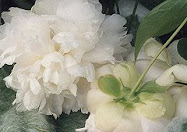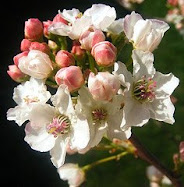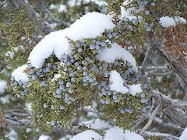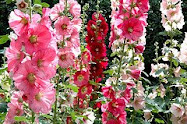 A key appurtenance for sanely navigating the long, frozen winter here in the north country is the simple houseplant. The houseplant allows us to be indoor gardeners when the outdoors becomes churlish. For an all-points outstanding indoor plant, the common regal or Martha Washington geranium stands right at the top of the crop of candidates.
A key appurtenance for sanely navigating the long, frozen winter here in the north country is the simple houseplant. The houseplant allows us to be indoor gardeners when the outdoors becomes churlish. For an all-points outstanding indoor plant, the common regal or Martha Washington geranium stands right at the top of the crop of candidates.Geraniums come in every flower color except blue and yellow, which in itself is a pretty remarkable attribute. The range of pinks, apricots, reds, purples, variegated, and whites give the gardener a delectable assembly of choices, and the opportunity to enjoy a diversity of flower color indoors. The flower heads open into bonny symmetrical sprays or spheres like small handfuls of summertime. Geraniums will flower continuously all year, a rare talent in the flowering plant kingdom.
The shape of the plants is also uniformly pleasing. The leaves favor dark green tints, or can be variegated green and white with pink or dark red edging. The tidy, full, rounded form of the geranium is worlds neater and more shapely than the many vining, trailing and spiky types of houseplants such as leggy spider plants, ivies and pendulous ferns. They don't require more space than a decent windowsill and do not grow to massive proportions which hog and block the scant winter light.
No houseplant is easier to propagate or maintain. They need only about four hours of direct light a day, and are perfect, well-behaved, decorative occupants for windowsills or tables, erecting their comely, colored flowers on short, straight stalks as a cheery foil against the bleak grey and white landscape beyond the windowpanes. From fall through spring, they like to drink slowly and allow their soil to get dry between waterings, which need be done only about once a week. They respond happily to potting up in plain old composted cow manure, eschewing any demand for expensive or fancy potting soil compounds. They are not persnickety, easily offended, high-maintenance divas, like orchids and African violets can be.
A brand new geranium plant can be generated through the dead-simple technique of cutting a well-leafed branch close to its base from an established plant, sticking the cutting into a pot of soil, tamping the soil down firmly around it to hold it upright, and keeping it moist for a couple of weeks. New leaf growth and soon, flowers, will follow. There are a couple of red geraniums on my windowsills whose ancestor plants harken back to many years' past. If you acquire a geranium you're particularly fond of, it really is a cakewalk to keep its offspring and new generations with you across the decades.
Once every couple months seems sufficient to apply a liquid fertilizer to potted geraniums to keep them blooming. The flowers open slowly over a lingering two-week period, hold in full flower for at least a week, and repeat bloom about once every month or so throughout the year and the seasons. Cut and placed in a vase, the flowers will last two weeks or more. Deadheading spent flowers promotes growth of new flower buds. Leaves that begin to yellow around the edges also should be pinched off at their base, and this action will encourage new, fuller leaf growth. If the plant appears stunted or yellowing occurs on lots of the leaves, it calls for a boost in nitrogen fertilization, and/or a reduction in the watering schedule.
A freshly potted geranium cutting takes about six months to become a vigorous, full-leafed adolescent, and will gain about six to eight inches in height during this time period. That growth chart makes geranium cuttings a great choice for harvesting from outdoor and container plants in autumn, slotting into a window, and enjoying the leisurely, blooming, compact development throughout the late fall and winter. By late spring, fall-harvested cuttings will be full grown, flowering plants that can then be transferred back to the outdoors as the centerpiece for containers or directly into borders, thus eliminating the need to purchase new stock. Start more new cuttings from the late spring houseplants before moving them outdoors and Bob's your uncle, you've got another crop of potted sprigs to grace your windows through the summer (when they will like drinks of water twice weekly with the increase in sunlight).
Most common geraniums have little scent except a faint peppery, spicy aroma if the leaves are rubbed. Scented-leaf geraniums can be obtained if that's to your liking, in flavors of lemon, rose, mint, nutmeg, apricot and more. Extract of geranium root has been renowned among the Zulu people of South Africa for centuries for its uncanny ability to rapidly cure nasal and chest congestion of flu, colds, sinusitis, strep throat and bronchitis. A British gentleman named Charles Stevens claimed in 1897 that South African geranium root reversed and knocked down his tuberculosis, and he went on to market “Stevens' Common Cure” tonic from it. Be that as it may, the geranium does possess anti-bacterial and anti-fungal properties, and boosts the immune system, so geranium-leaf tea or a root tisane could come in handy for under-the-weather spells. As well, geranium leaves, in common with all green houseplants, will purge the indoor air of toxins produced by wood fires, tobacco smoke, candles and cooking.
The author Victoria Glendinning maintains that conversing with your geraniums will make them even more blithesome comrades, but cautions against overdoing it or pouring your heart out to them in a fit of cabin-fever solitariness. “A kind word every now and then is really quite enough,” she opines. “Too much attention, like too much feeding and weeding, inhibits and embarrasses them.” Heaven knows, given all the pleasure and companionship they afford the gardener, the last thing on earth one wishes to do is to embarrass one's geraniums. Maybe just the occasional, “How are you today? Get you anything?,” is about right to encourage and thank geraniums for their houseplant finesse.
















